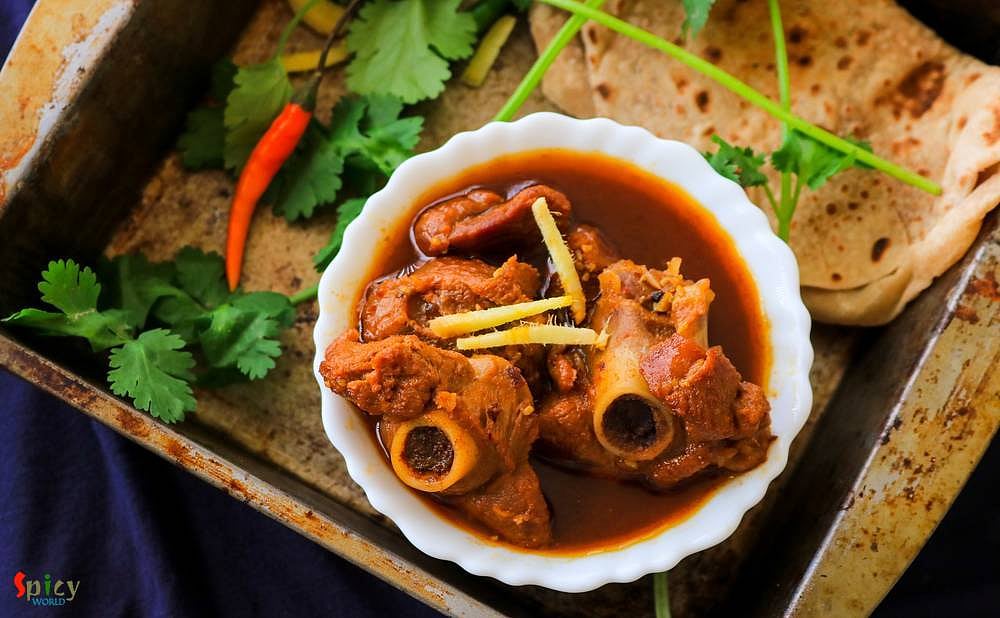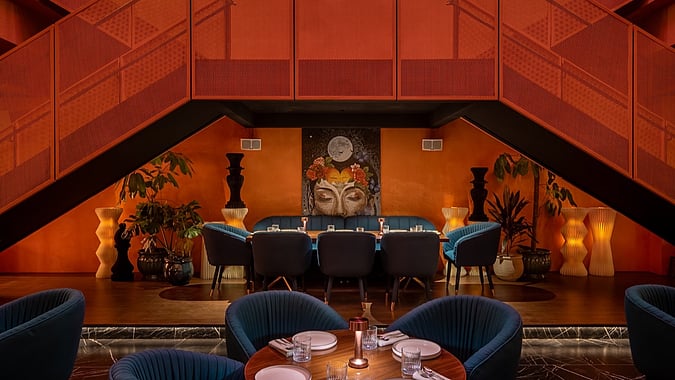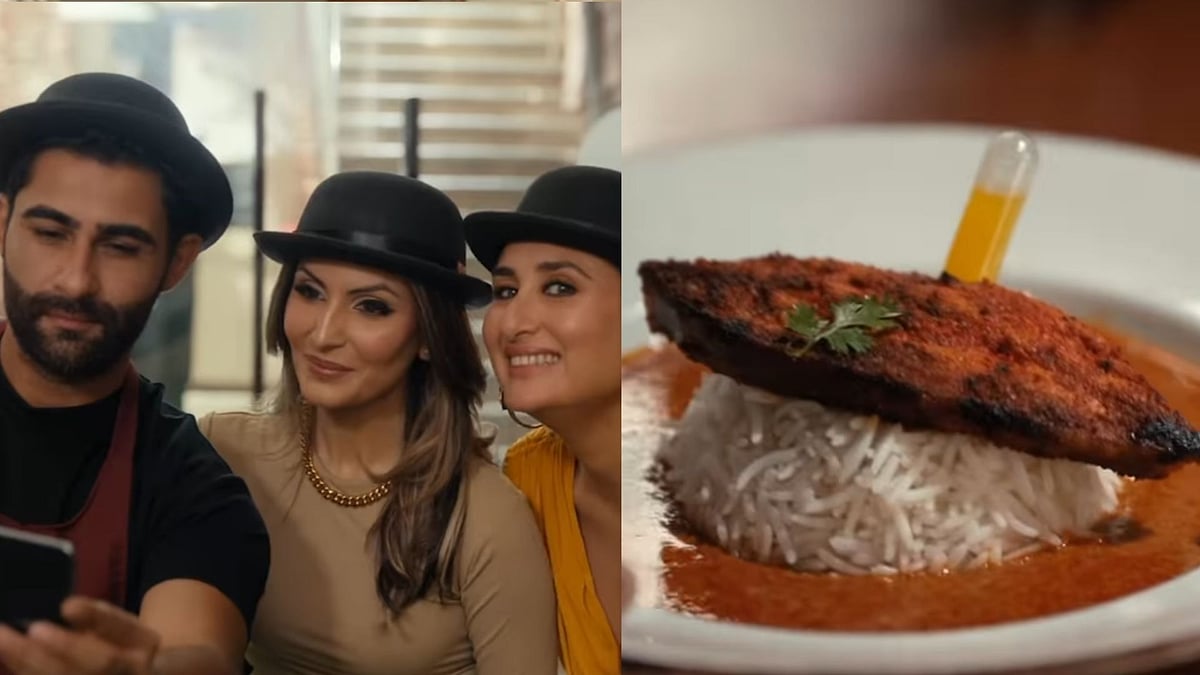So much about Kashmir is celebrated, nuanced and none more so than that aromatic Rogan Josh, one of India’s most famous curries. On a trip to Srinagar last year I finally learnt what goes into this much loved dish. And I was pretty surprised. No dish has bewildered me as much as the Rogan Josh, a dish, like Vindaloo that has so many hotch potch versions, (some just completely bizarre) available in restaurants and online. This shouldn't be surprising - with the violence in Kashmir there is a lot less 'sharing' of Kashmiri culture in the mainstream than there should be.
Kashmiri cooking traces its history to the 15th century when Timur the Lame (a Turco-Mongol) invaded India, resulting in the migration of accomplished woodcarvers, painters, weavers, architects, calligraphers and cooks from Samarkand to the Kashmir valley. Wazas are Kashmiri cooks with a lineage that traces its origins to Uzbekistan.
The descendants of these cooks are the master chefs of Kashmir. So this elaborate feast prepared on special occasions came to be called Wazwaan. I had the good fortune to talk with Ghulam Mohammed Bhandari Waza, a renowned chef in Srinagar with assistance from Arif Shah, a local Kashmiri and a foodie. Ghulam Mohammed’s father and grandfather were also Wazas, but unhappily his son doesn’t want to be one. Arif, who translated our conversations from Koshur to English, tells me the younger generation feels it is not a profession given the respect it is due. This is disheartening news, so many Kashmiri traditions like the artists who wove and embroidered those epic shawls called jamawars, the wood workers of Khatamband, Ferozi and Pinjra kari and the makers of Wagu mats have given up their trades. Many artisans have left the valley as the demand created by tourism has dwindled in the wake of terrorism. It is crucial these authentic recipes are preserved and as I was lucky enough to get many of them including Dum Aloo and Gucchi Pulao. I hope you will consider cooking them up.
Kashmir is a syncretic culture with myriad influences beginning with the trickle effects of the Persian Achaemenid invasions, followed by Alexander the Great’s attempt to invade Punjab, arrival of Turkish scholars, the Central Asians, some who later came to be called the Mughals. Kashmiri food is complex and beautiful and, like its culture and crafts, an alloy welded by some of the world’s greatest warriors and civilizations.
While the name Rogan Josh is Persian, the techniques and ingredients involved are diverse. Roughan means “oil” in Persian, while josh means to boil. Interestingly, the Muslim version of this dish involves boiling, while the Pandit recipe involves searing and braising. There is undoubtedly an Indian influence in the use of ghee and a large number of spices. Some of the ingredients such as Alkanet are of Mediterranean origin, Mawal or Cockscomb flower, it is argued, is of African origin.
Facts I learnt about Rogan Josh (please send me an email or tweet if you disagree)
There are two versions of Rogan Josh The Hindu Kashmiri Pandit version, which is more easily found on the internet and the Muslim version, which I obtained from Ghulam Waza. You will be surprised how different the two are.
Rogan Josh is also made with chicken. You will find a good recipe for it in a book called Wazwaan by Khan Mohammed Sharief Waza and his brothers.
The Pandit version does not use garlic and onions while the Muslim version uses Kashmir pearl garlic and shallots called pran (see grocery list below).
The Pandit version uses dried ginger.
The Pandit version uses yogurt, the Muslim version doesn't.
The ideal meat is mutton and if unavailable lamb. The best and traditional cut is the shoulder for the Kashmiri Pandit version. The Muslim version often uses meaty goat ribs called champh.
Several natural colouring agents unique to Kashmir are employed. Mawal or red cockscomb flower in the Wazwaan version, and rattan jot, a kind of wood shaving known as alkanet root or Alkanna tinctoria in the Pandit preparation. Saffron is used in the Muslim version and alters the taste because saffron, unlike Mawal and Rattanjot, has a strong flavour.
Tomato is incorrectly used as a substitute when Mawal and Rattanjot are not available. No authentic version of Rogan Josh I ate or saw being cooked in Kashmir has tomatoes. Kashmiri chilli is also added in excess sometimes to produce a dark color. This is incorrect because Rogan Josh is not a burn your tongue off dish.
In a Wazwaan the traditional Muslim meal, it is always the Muslim version of Rogan Josh with onions and garlic that is served.
The Hindu version uses aniseed and asafoetida or hing to replace garlic.
The Muslim version uses ghee, the Hindu version also uses ghee and sometimes mustard oil. Both use dried Kashmiri chillies.
Rogan Josh is served with rice.
Rogan Josh has both a distinct color and aroma that you know instantly when the dish is placed before you. Kashmiri food is especially aromatic whether it is Haak or Gucchi Pulao the aroma is as distinct as coloUr and piquancy.
Kashmiri Pandit version (Serves 5-6)
1 kg mutton or lamb shoulder cut in pieces
For Tempering
3 tbsp mustard oil
3 tbsp ghee
1 black cardamom
3 green cardamom whole
2 inch cinnamon stick or dalchini
1 large dried bay leaf or tejpata
1/4 tsp asafoetida or hing
For Rogan Josh Masala
1 teaspoon aniseed powder (powdered saunf)
2 cups full fat plain yogurt or curd (not sour)
1-2 teaspoon freshly roasted and ground Kashmiri red chilli
1/4 cup of rattan jot or 50 grams Mawal (dried cockscomb flowers) or a 1/2 tsp of dark red beet powder
Instructions
Rinse the lamb shoulder in stock pot of hot water. Drain completely. Boil the ratan jot or mawaal in 2 cups of water until reduced to 1/2 cup. Drain and reserve colored liquid.
Heat oil and ghee on a medium flame.
Add all the whole spices and cook until fragrant about 1 minutes. Then add asafoetida.
Add the lamb or mutton pieces and cook on high heat to sear the meat. Using tongs remove the meat and set aside on a plate.
Add yogurt, aniseed powder, red chilli and yogurt. Stir well and cook on a medium flame until the yogurt splits, then comes together and releases its oil on the sides.
Return the meat to the yogurt mixture. Add the colour and a teaspoon of salt. If the colour is not red enough add more.
Toss well and cook on a slow flame until meat is tender.
Add more water a little at a time during the cooking process. This is eaten with rice so you must have gravy.
Add more red chilli and salt as per your taste.
Serve warm with rice

Kashmiri Pandit version |
Traditional Muslim version (Serves 6)
For the stock
1 kg mutton ribs or champh
3 pearl kashmir pearl garlic cloves peeled, lightly bashed or 6-8 regular peeled cloves
2 pieces of black cardamom
3 pieces of green cardamom whole
3 pieces of cloves
3 pieces of cinnamon about 2 inches
for the kashmiri chilli paste
8 dried kashmiri chillies, stalks and seeds removed
for the rogan josh paste
6 pran or kashmiri shallots peeled and chopped
2 tbsps ghee
1/2 cup vegetable oil
For the colour
50 gm dried mawal flowers
8 strands saffron crushed with a mortar and pestle
1/2 teaspoon ground turmeric powder
for the garnish
1 peeled green cardamom pod seeds finely ground
Salt to taste
Instructions
Heat 1 liter water on the fire and boil the mawal flowers until you have a bright red color and the water is down to 1/2 cup of liquid. Drain and reserve this liquid.
Put 1 kg mutton or ribs (champh) in 2 litres of room temperature water and boil it on a low flame for 5 minutes. Strain the mutton out and discard the remaining water. This helps to soften and clean the mutton.
Put 2 litres of water and the strained mutton into the same stock pot with the garlic, black and green cardamom, cloves, cinnamon and 1 teaspoon salt.
Boil this for 30 minutes on a high flame. Do not steam the mutton or use a pressure cooker, it has to be boiled on high heat with a loose lid over the vessel.
Strain out the mutton pieces from the stock and filter entire stock through a piece of muslin cloth known as peera cloth in Kashmiri or use a fine steel strainer.
Reserve the ribs or meat pieces on a plate and discard all the spices.
Heat oil in a skillet on medium flame and saute the pran or shallots in ghee until deep golden and soft.
Use a little mutton stock and grind these onions to a smooth paste.
Boil the red chillies in 1 cup of water until water is mostly evaporated. Drain and grind chillies to a smooth paste.
Add the chilli and pran paste to the stock. Add 1/2 teaspoon turmeric and the mawal liquid concentrate. Return ribs to stock and cook on a medium flame without a lid until stock begins to thicken.
Stir in the saffron.
Cook this enriched stock until mutton is tender and gravy thick. Salt to taste
Just before serving sprinkle with a little ground cardamom.

Traditional Muslim Version |









